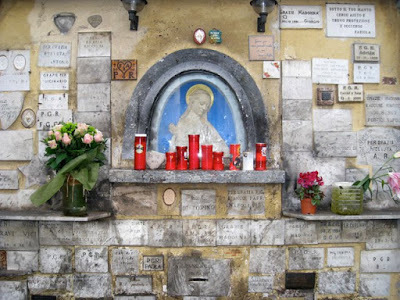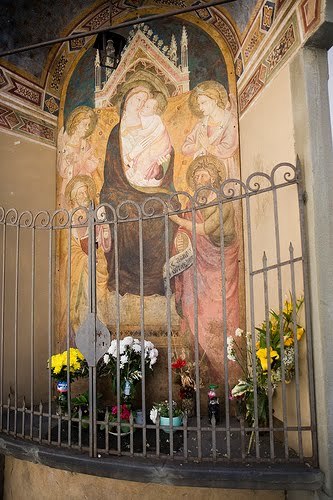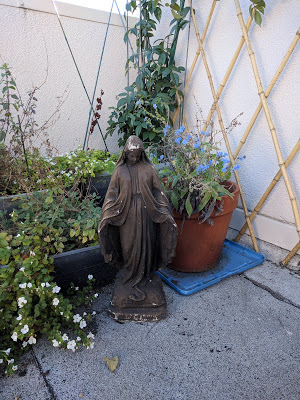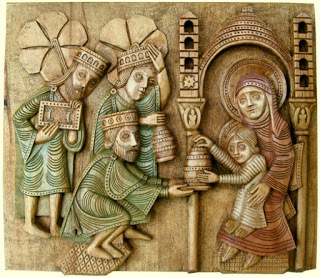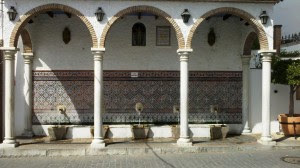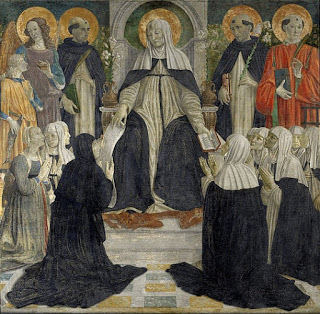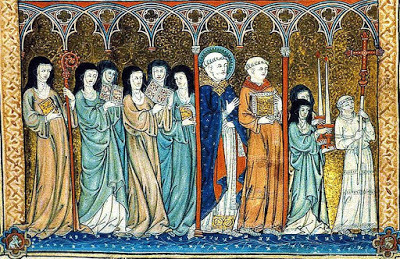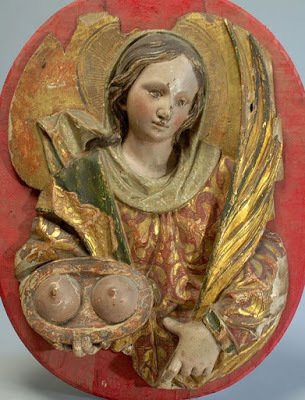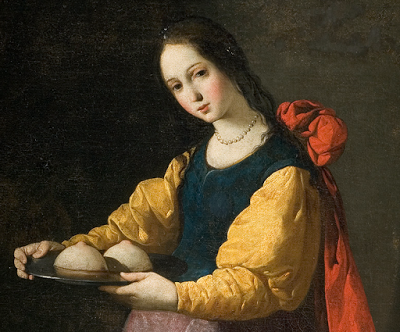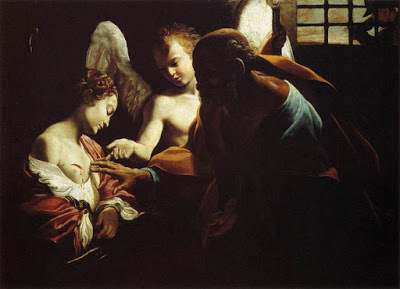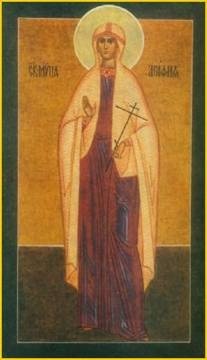David Clayton's Blog, page 3
February 20, 2018
Are You the Gardener? A Lenten Reflection From a Priest of the Institute of the Incarnate Word
From a priest of the Institute of the Incarnate Word
We are now in the first week of Lent. In order to aid our passage through this important liturgical season, we offer weekly meditations. Each is written by a priest from the Institute of the Incarnate Word, IVE, and we are delighted that they have taken the time to do so. The first focuses on some general thoughts for Lent and is by Fr Brian Dinkel, Pastor of Our Lady of Peace in Santa Clara, CA. He writes:
With due reason, the archetypal setting for the Lenten season is the desert. The arid desolate land that purges us from the attachment to the comfortable life of sin, which goes no further than self-satisfaction. What about Gardens? As much as our senses and inclination to comfort may need some desert time for detachment, so too might our intellect and will need some time spent in the Gardens for conversion. Let us explain.

The Old Testament line that inaugurates Lent for most is: “Remember you are dust and unto dust, you shall return.” (Genesis 3:19) These words are spoken in a Garden, Eden. In this Garden, through an act of disobedience, Adam and Eve turned from God. This is followed by what Bl.John Henry Newman wittingly describes as “The original excuse.” (Cf., Bl. John Henry Newman, Oxford University Sermons, Sermon 8) First Adam points to Eve saying, “The woman whom you put here with me—she gave me fruit from the tree,” and then Eve places the onus on the serpent, saying, “the snake tricked me, so I ate it.” (Genesis 3,12-13) In another other Garden, Gethsemane, we witness a supreme act of obedience to the Father.
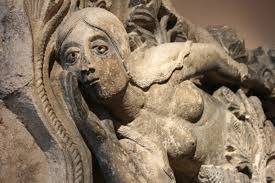
Jesus speaks to His Father with child-like simplicity: “Father, if Thou art willing, remove this cup from Me: nevertheless, not My will, but Thine, be done.” (Mt 26,42) In this Garden, however, He makes Himself the excuse for everyone else. The Garden of Eden is where life is
springing forth on all sides, but selfishness leads to death. In Gethsemane, death is all-encompassing, but in this garden, selflessness leads to life.
His soul was sad to the point of death. He felt within His soul a sadness that was deep enough to cause the feeling of death. The Greek adjective περίλυπος (perilypos: from peri‐ around + lypé sorrow, grief) means properly, around‐sorrowful, that is, sorrowful all around, encompassed with sorrow; i.e. exceedingly sorrowful. (Cf., Mt 26,38) Therefore, the Jesus Christ, as St. Paul describes it, became sin, “for our sake he made him to be sin who did not know sin.” (2 Cor 5,21) The moral sufferings of Jesus were without comparison; they were tremendous; they were of greater suffering than the very nails that pierced His hands and His feet. It was so intense that He sweat blood.
After all of this agony, He calls us into communion with Him this day. He gives us the blessing to be with Him, to receive Him, to be in communion with Him.

We have to look at, take ownership of, and reject what we have done. We must also acknowledge and cherish what He did, for me, in order for my heart to begin to change. One needs to see the darkness and evil of sin, that it is mine alone, and that Jesus – the Innocent Lamb
– has taken it upon Himself to free me from them. As Pope St. John Paul taught, “Sin is an integral part of the truth about the human person. To recognize oneself as a sinner is the first and essential step in returning to the healing love of God.”
I need to see this, I need to look at this, in order for there to be real, lasting change; otherwise, I never see myself honestly, nor do I give the great price that Jesus paid for me an honest consideration. Our faith, religion, is more than pursuing happiness or self-realization – it is friendship and love. He took on a terrible amount of filth for me and He continues to call me like a loving friend who says: “forget about it – I don’t condemn you, I absolve you and forgive you, but go and sin no more.”
Our hearts must change. Ash will probably not do it, but maybe God—so meek and humble who came down from heaven, clothed Himself in our sins and poured forth blood from every pore of His body—will.
Here, in this Garden, Jesus places the sins of all human beings upon His shoulders. Thinking of the circumstances, the number, the malice, the ugliness, my own sins, . . . sins of a culture, of a society, of governments, our uncontrollable pride that in the name of liberty we unhinge ourselves from subjection and when faced with our ruin we place the blame on God who did not intervene or we reject Him altogether. He who knew no sin, placed upon himself all of this.
He can take away from these awful things something good – His Passion is our Redemption. He wanted to give us the sacraments. Therefore, no matter how bad our sins may be, or have been, God’s love is Greater – out of love for us He clothed Himself in this suffering. 2. Love – the love of God for each and every one of the members of His Mystical Body. Jesus saw all of His disciples, those who would follow Him, He also saw all of our infidelities. How we place our affections on material things, the insults that we make towards one another, the divisions, the hatred, the calumny, . . . He saw the lukewarmness and indifference of His friends.
He saw all of this, the martyrs of all times, the sufferings of the members of His body. He suffered these as if it were His own body. These were His members. The innocent ones who were forgotten or abused, thrown away by a society. For this reason, we know that Jesus
suffered when we suffer. And this produces a profound suffering in His person. The Father in His infinite Love sent an angel to console Him, as His friends could not stay awake and watch one hour with Him.

Paintings are by Bosch, Goya, and Tiepolo respectively.
February 19, 2018
Florentine Street Shrines – Can We Do This Today? Will Today’s Della Robbia Please Step Forward?
When I was studying portrait painting in Florence, several years ago, I was struck by the charm of the old street shrines that can be seen built into the walls of the buildings that line the narrow streets. Many date back to the time of the building itself.
Not all are still obviously the focus for prayer, many seemed to unnoticed in a city in which Renaissance art abounds and much of the population has fallen away from the Faith.
Since then I have wondered, from time to time, if this is something we could do today, in a time and in places where Catholicism is not the dominant faith and the driving force the culture?
My feeling is we might, in many instances, struggle to persuade local government to go along with such a thing. However, perhaps if done tastefully and discretely on private property that is visible from the public street it might be possible.
I suggest that if what is done is truly beautiful, even non-believers would want it and it would, to a large degree, disarm potential critics by removing their desire to be offended by outward signs of the Faith. I have a friend who runs a menswear shop in the UK and he always places a small icon of the face of Christ, a Mandylion, which is just 6′ x 4′ in size, low down on the wall behind the counter. While it is not an obviously bold statement of faith, he deliberately places in such a position that when people pay for their clothes, they will see it on the wall behind the till in such a way that it gives the impression that they are peeking into his personal space and seeing an image that is their for his private devotion. He says that nobody ever objected, and many asked about it.
Non-Christians (and for that matter many Christians too) are much more likely to be irritated if the art is ugly or sentimental. I have often wondered, for example, if the militant secularists are in fact doing us a favor by objecting to the kitsch shopping mall nativity scenes that seem to be standard issue for retailers nowadays. Perhaps they are the unwitting agents of the Holy Spirit? Before my conversion in my early thirties, piped carol music and brightly-colored plastic McChristmasses gave me the impression that Christianity was for saddoes who didn’t even know that they ought to be embarrassed by being associated with this stuff. This did far more to put me off the Church than tales of Popes fathering illegitimate children or the brutality of the Teutonic Knights in the Baltic and the Middle East!
If we did decide to do this, what form should it take?
Well, here’s an idea. I recently posted a photo of my first stab at creating an outdoor icon corner in a balcony garden.
I am hoping that as the plants grow through spring and summer that the hard edges will soften and overgrow, slightly the images. The paintings are prints that I obtained from a website selling them on rustic wooden planks, which I have varnished and screwed to the stool, which came from a consignment store.
A reader saw the photos and got in touch with me, suggesting that someone might like to start producing ceramic tiles with the standard core images of the icon corner – Our Lady on the left, the crucifixion in the center and the Risen Christ on the right which could then be set into the wall.
I do not know the economics of tile production but wouldn’t it be wonderful if we could have beautiful triple sets of tiles? I imagine they might be something like the Della Robbia ceramics, except stylistically gothic or iconographic (just to suit my personal taste) and polychrome. Maybe in the form of a Jonathan Pageau relief carving!
Here is an original Della Robbia:
I once wrote a feature on my blog, thewayofbeauty.org, on how houses in southern Spain have tiles containing geometric patterns set into the walls of their houses – a Christianization of the Islamic cultural inheritance, here: Geometric Tile Patterns in Andalusia.
Perhaps we could have a combination of the two ideas in which we start to have simple icon-corner triple sets set into such patterns? If done well, it could the house prices up – even if you are selling to an atheist, I suggest!
Just a thought.
February 15, 2018
Creator and Sub-Creator, part I
“We are made in the image and likeness of the Creator of all things and as such, we share in His creative power. Man is, in effect, as J.R.R. Tolkien put it, a sub-creator.”

The Parable of the Painter
There was once an artist, a painter of consummate skill who conceived a great work. He first spent weeks sketching and refining his inspiration. His studies for the various elements were works of art in themselves. When he was satisfied that he had captured his vision he began the task of preparing his support.
He spent days searching for the finest canvas, and days more stretching and preparing the canvas for paint. He sealed the surface with a foundation of gesso, sanding and reapplying until the ground held the perfect tension upon which to paint.
The paints he mixed himself, grinding the pigments and mixing them with a medium of his own invention. Finally, after many weeks, he was prepared to begin the painting.
He worked with skill and confidence. His brush never hesitating or erring. His composition was perfect, it held the eye and the imagination to such an extent that the viewer lost all track of time, gazing in endless wonder at the arrangement of the elements. The colors showed a harmony seldom seen, vibrant and luminous, echoing the music of the cosmos.
When at last he laid down his brush, the painter stepped back and saw the great beauty of his work. Exhausted from the effort, he then took his rest.
But the painter had an enemy, one who, out of envy, sought to disrupt all that the painter created. While the painter slept the enemy came into the studio and introduced a flaw into the foundation of the work. This flaw grew, spreading over the work threatening to destroy its beauty.
When the painter awoke and saw the damage done to the work, he thought first to destroy the painting and begin the long process again. But the work was precious to him, a child of his imagination, and he could not bear the thought of destroying it. He considered correcting the flaw but feared that it would simply reappear as it now had become part of the work itself.
Finally he concluded there was only one way to save the work. He painted himself into the work and taught the work how to correct itself.
In His Image and likeness
In the story of the fall of man from the Book of Genesis, the serpent is hard at work trying to undermine God’s creation. The serpent comes to Eve, the mother of the living, and asks her,
“Did God say, ‘you shall not eat of any tree in the Garden’?” But Eve responds “Of the fruit of all the trees in the Garden we may eat; but ‘Of the fruit of the tree in the middle of the Garden ,’ God said, ‘you shall not eat, neither shall you touch it, lest you die.’”
But seductive voice of the serpent was ready with an answer, “No, you shall not die; for God knows that when you eat of it, your eyes will be opened and you will be like God, knowing good and evil.” (Genesis 3:1-5)
But the words of the serpent were a lie. Only a few verses before, we read, “God said, ‘Let us make mankind in our own image and likeness,’” (Genesis 1:26) Being made in His own image and likeness, man was already like God.
What does this mean, to be made in the image and likeness of God? What does it mean for the creative individual, the artist that is part of every human being? Traditionally we are taught that being made in the “image and likeness of God” means that man was created with free will and an intellect, in imitation of God’s perfect will and understanding. But we can go further. We are made in the image and likeness of the Creator of all things and as such, we share in His creative power. Man is, in effect, as J.R.R. Tolkien put it, a sub-creator.
this article originally appeared at www.DeaconLawrence.org
______________________________________
Pontifex University is an online university offering a Master’s Degree in Sacred Arts. For more information visit the website at www.pontifex.university
Lawrence Klimecki is a deacon in the Diocese of Sacramento. He is a public speaker, writer, and artist, reflecting on the intersection of art and faith and the spiritual “hero’s journey” that is part of every person’s life. He maintains a blog at www.DeaconLawrence.org
February 13, 2018
A Young Nun Tells Us How Wearing the Habit Helps Her to Live Out Her Vocation
The habit provides us with a freedom which to the world seems a restriction.
The anonymous Sister who wrote these words is currently a student at www.Pontifex.University and she wrote them for an essay set for a class Final. She is one of the sisters of a community in Santa Rosa, California, called the Marian Sisters of Santa Rosa, and is a seamstress for the community. Her duties include making the community’s habits. I asked her to describe why she felt this work was important, before going on to describe (in the next essay) how this informs her work in making the habits for the other Sisters.
The essay is entitled A Visible Witness; what struck me about it particularly were her anecdotes of personal reactions to the habit. She writes that it was seeing nuns wearing habits when she was a little girl that spoke to her of this “alternative” lifestyle (if I can use that phrase!) I found her accounts of the positive responses of ordinary people to her when they see the habit especially charming. For ease of reading, I have removed the footnotes and references from the original essay. The photograph below is taken from the community’s website.
She writes:
Early in the Church, those who dedicated their lives to God wore some form of identifiable clothing that distinguished them from the world. The purpose was to visibly set them apart from the world for God’s service. Through the centuries this type of clothing, namely the religious habit, has taken many shapes and forms in the diverse communities that God has called into being. During the past sixty years, the value, relevance, and need of the habit has been disputed. However, many young people with vocations to religious life are being drawn to communities that do wear the habit. It is my opinion that in our world today, this visible witness of the religious habit is still needed to silently but eloquently proclaim the reality, presence, and primacy of God.
One of the first references of any sort of garb for those who gave their lives to God is in the writings of St Pachomius, who founded the cenobitic way of life in the fourth century. In his Rule, he requires all those who pass the initial tests for entrance into the monastery to be stripped of their secular clothing and be clothed in the monastic habit. St Benedict and St John Cassian also prescribe the clothing in the habit in their Rules. St Augustine also refers to a plain and simple habit for both men and women religious. This new and different clothing was a symbol of renunciation of the world, and the simplicity and poverty of religious life. No monk was to have anything different than another so that there could be no cause for contention over material things. For women, the veil was also given as a special sign of consecration to Christ, their Divine Bridegroom. Since the time of St. Ambrose, there has been a special ceremony of conferring a veil on a virgin. The veil is also a public symbol of the nuptial union of Christ and His Church.
The religious habit was valued as the strong visible witness of a life given to God, and so continued as part of religious life. Religious habits remained simple, often in black, to signify the death to the world and to self that the religious life entails. Various parts of the habit, such as the scapular, were added as time went on, but the essentials of the tunic, belt, and veil, for women, remained consistent. St Benedict in his Rule refers to the scapular as being a garment worn for work. The scapular is a garment made of two long pieces of fabric, roughly the width of the person and the length of their height, joined together at the shoulders so that one piece falls in front and one in the back of the person. It was originally used as an apron, protecting the tunic while working. St Simon Stock and St Dominic were both given the scapular directly from Our Lady to become a regular part of the habit of their respective orders. At the end of the twelfth century, St Dominic saw a vision in which Mary held a scapular which was to be part of the Dominican habit. Around the same time, St Simon Stock received the Brown Scapular as a pledge of salvation for all who wear it and it has become a sign of Her protection of the soul. The scapular, as well as each part of the religious habit, took on a special meaning as the privilege of wearing the habit was better understood.
As different orders started in response to God’s call, each one assumed a distinctive habit that would distinguish the different orders from one another. Benedictines were known by their black habits, Dominicans wore white tunics and scapulars symbolizing purity, and Franciscans were recognized by their brown or gray robes for poverty. For women, the black veil was often a sign of profession, succeeding the white veil of a novice, usually worn over a white wimple which covered the head and neck of the sister. As more orders of sisters were founded, many interesting and distinctive forms of the habit, especially the veil, came into use. The front of the veil could be rounded or square, fit closely over the face, or widely fall over the shoulders. There were veils that had frills around the face, a box-like shape, or even a starched bow under the chin. Different colors were sometimes used, such as blue in honor of Our Lady. While retaining the essence of a garb set apart for God, each different community could be known by the sister’s particular habit.
In the 1950s, it was recognized that some of the parts of the religious habit, especially for women, had become overly complicated or impractical. Some communities used many yards of material in the tunic alone. The amount of material made it hard to wash frequently and expensive to make. Another example is the veils which came so far around the face that it eliminated the sisters’ peripheral vision. For sisters learning to drive a car, this would be dangerous. Pope Pius XII in 1951 commented on the need for a modification of the habit to suit the present needs.
Shortly after the Second Vatican Council, the topic of modifying the habit again was addressed and communities, in obedience to the Church, considered revising this aspect of their religious life. With all the other social issues going on in America, such as the radical feminist movement and concern for social justice, it seems that many American sisters interpreted the call for modification as permission to cease wearing the habit altogether. From my perspective, they thought in goodwill that for the sake of “equality” and “the liberation of women”, sisters now were not forced to wear such restrictive clothes that were remnants from unenlightened and past times. In some communities, this erroneous interpretation was held by sisters in authoritative positions, and so entire communities were deprived of the habit. This was not the case for all communities. Many did follow what the Church truly desired in simply modifying their habit in such a way that it retained its character as a clear, visible witness of Christ. In addition to these faithful communities, many new communities who wear the habit were started in America. The growing communities of sisters are those who do wear the habit because young women who hear the call to religious life recognize the need for it more than ever in our world today.
In the past 60 years, the Church has given much instruction on religious life, including the topic of the religious habit and its value. In the Code of Canon Law, it states that “Religious are to wear the habit of the institute, made according to the norm of proper law, as a sign of their consecration and as a witness of poverty” (669, §1). Pope St John Paul II explains the reason for this in his apostolic exhortation Vita Consecrata.
“The Church must always seek to make her presence visible in everyday life, especially in contemporary culture, which is often very secularized and yet sensitive to the language of signs. In this regard, the Church has a right to expect a significant contribution from consecrated persons, called as they are in every situation to bear clear witness that they belong to Christ.
Since the habit is a sign of consecration, poverty, and membership in a particular Religious family, I join the Fathers of the Synod in strongly recommending to men and women religious that they wear their proper habit, suitably adapted to the conditions of time and place”.
Other Church documents, including the Decree Perfectae Caritatis, reference the necessity of the habit and how it should be modified according to current needs. The Church recognizes and articulates that the habit is important. It provides the visible witness that Christ is first in our lives and that a religious strives to live completely in that reality. Wearing the habit exclusively declares that the religious do not worry about material things, and relies on God for all temporal needs. The simplicity and poverty of the religious life is manifested by having only one thing to wear, for everyday work as well as the most formal occasions. Even if a community’s habit needs to be modified for practical reasons or for the particular apostolate, it is still to be a clear sign of consecration to all, including the religious herself. The habit bears witness both to the reality of God, and that we are to be living and working solely for Him.
The habit is very connected to my vocation to the religious life. In the diocese of Santa Rosa where I grew up, there were a few sisters from three different communities ministering in the schools and the hospital. However, if I had not been told, I would not have known they were sisters because they did not wear a recognizable garb other than professional-looking clothes, a lapel pin, or cross necklace. Besides the saints who were religious, the other community of sisters I was most familiar with was the Poor Clares of Perpetual Adoration on EWTN. Wearing the full habit, they were an unmistakable witness of religious life. At age six or seven, I thought I was going to be a nun, which in my mind meant going to Alabama to that community. My sister and I would play that we were nuns and always wore fabric on our heads for a veil since we knew that was part of being a nun. Even at that young age, I had an intuitive sense that being a sister involved wearing a habit. The thought never even crossed my mind to be like the sisters in my diocese, since I just thought they were a different kind of sister and not the kind that I would want to join. After high school, when I was seriously discerning the religious life, the habit was a necessary component of any community I considered. If God was calling me to be a sister, I desired to look like one. The Marian Sisters of Santa Rosa, who had just come to the diocese, wore a beautiful habit of white and blue. There was no question of who they were since their clothes proclaimed that they belonged to God.
Since receiving the habit of the Marian Sisters of Santa Rosa, I am so grateful each morning to dress in this habit. The habit provides a freedom that to the world seems like a restriction. I am free from the worry of what to wear if it will be appropriate for the occasion, if the color suits me, or if it is modest enough. It takes much less time to get ready for the day when putting on the habit since there is no deliberation involved. When wearing secular clothes, one outfit is tried on, and then removed to try another, until, after much time and effort, a set of clothes is decided upon. Now, my time is used to beautify my soul for the reception of my Spouse in Holy Communion later that day. To the world, only having one choice might be seen as a lack of creative freedom to express my personality by what I wear. In my experience, never having other options of what to wear frees me from thinking so much about myself to think about the more important things in life. While donning the holy habit, I am praying, asking God for the strength for what I am to face that day, and clothing myself in His grace. Creativity is not suppressed but redirected away from myself to invent new ways of giving glory to God and showing love to Him and those around me. My personality, instead of being stifled by the habit, is revealed even more clearly through my actions and words because my clothes are not a distraction. Wearing the habit, I am free and even expected to pray in public, and to say “God bless you” to everyone because I am what I look like: totally dedicated to God.
When any of the sisters walk or go anywhere, we receive attention because of the habit. Some people spontaneously ask for prayers, intuitively trusting in our intercessory power with God. Others will relate stories of being educated by nuns, or share fond memories of an aunt who was a nun. Many comment on the beauty of the habit, happily surprised to see it after thinking it was a thing of the past. These are some of the responses we receive from those who come up to talk to us, but many more see us and are affected by the presence of God apparent in us, even from a distance. To travel to my apostolate, I walk for ten minutes along one of the busiest streets in the city. Hundreds of cars pass me each morning as I pray my Rosary. One day recently, I received the comment, “I saw you on the street corner, and thought how beautiful your outfit, or whatever you wear, is!”. It is not uncommon for a generous soul to anonymously pay for our meal, or grocery purchase, not because they have talked to us, but because they know who we are by the habit. Though we might never interact with those who see us, we pray that we are a channel of grace to bring them closer to God.
The habit, while being a sign of God’s Presence in the world, is also a reminder to the religious herself of who she is. In my experience, the habit aids recollection and prayer in times of formal prayer, as well as when going about my duties. The sides of our veil, coming over our shoulders, act as slight blinders to our peripheral vision, directing our focus straight ahead to God. Our habit is long, obliging us to move with care and Mary-like grace. When I am struggling, or need assistance with anything, I find my hand reaching up to clasp Our Lady on my Miraculous Medal. As a professed sister, I wear a ring, reminding me that I am Christ’s Bride before any role or duty I have in the apostolate. I know, whenever I am acting, that I act not as an individual, but as a representative of Christ, His Church, and our community. The respect or attention I receive from others is not for me as an individual, but on account of the habit, it is for Christ, whose bride I am and whom I reflect to the world.
The religious habit is the beautiful sign of consecration to God since the early Church. All who see it are reminded that there is a higher purpose in this life than the concerns of this world, that there is some reason, namely the love of God, that religious would dress in this way. The habit declares without words that this person has a strong relationship and intercessory power with God. The value of the witness of the habit is proved by its resurgence in the Church and will continue to be a clear manifestation of God to the world.
February 9, 2018
David Clayton on Annuciation Radio, 4 pm Monday,
I am appearing on Annunciation Radio – annunciatioradio.com – interviewed by Patricia Ode-Murray for the Virtuous Life show. It will be aired on Monday 4pm EST and posted on the website after that as a podcast, here.
The topic is beauty and the culture, with a special interest in a formation in beauty as outlined in my book, the Way of Beauty and which is offered in the Pontifex University Master of Sacred Arts program
February 8, 2018
The Christian Artist – A vocation of service
“One characteristic of a Christian Artist is his love for God which motivates him to put his gifts and talents at the service of the community. “

What is the true vocation of a Christian Artist?
A vocation is a calling, for the Christian artist it is a calling to beauty. But it is also a vocation of service.
There an old story about a man who sought to understand the Law, the Torah, in a concise simple way. He went to his Rabbi and asked the teacher to explain all of the Law while standing on one foot. The Rabbi dismissed the request as foolish. The Law was extensive and covered many different circumstances, how could it be explained in the brief time you would be able to stand on one foot?
But the young man did not give up so easily. He went from rabbi to rabbi, asking each of them the same question. He was met with ridicule, scorn, and sometimes outright anger and hostility. But finally he came to Rabbi Hillel.
“Rabbi,” can you explain the whole of the Torah to me while standing on one foot?”
Hillel thought for a moment, stood, slowly raised one foot and said, “what you yourself despise, do not do to another. The rest is commentary, go and learn.”
A somewhat similar story is recorded in the Gospel according to Matthew
A Pharisee, a doctor of the Law, challenged Jesus, “which is the great commandment in the Law?” (Mt 22:36) He was not referring specifically to the ten commandments, but rather to the Torah, the Law of Moses. In other words, out of all the commands, rules, precepts and instruction that make up the body of the Law for the ancient Israelites, which is the greatest?
Jesus answers by paraphrasing an ancient prayer, the Shema, “”You shall love the Lord your God from all your heart, and with all your soul and with all your mind.” (Mt 22:37)
But then Jesus takes it a step further by referring to the second great commandment, “the second is similar to it: ‘You shall love your neighbor as yourself.’” (22:39)
Jesus tells us that our love for God is reflected in how we love our neighbor.
Before His Ascension into heaven, Jesus gave His followers a new commandment, to love one another as He has loved us. No longer are we called to love our neighbor as we love ourselves, now we are to love each other as Christ loves us. To love one another to the point of sacrificing ourselves for another. This is the defining mark of the Christian, the love we have for one another.
One characteristic of a Christian Artist is his love for God which motivates him to put his gifts and talents at the service of the community. The Christian artist does not engage in “Art for art’s sake,” his art serves his community.
The Christian Artist uses his gifts to lift the hearts and minds of people to God, whether his subject is a landscape, a still life, or a saint, whether he is a painter, a musician, or a craftsman. Love for God is the defining characteristic of all Christians and shapes all that we do.
“Everybody can be great…because anybody can serve. You don’t have to have a college degree to serve. You don’t have to make your subject and verb agree to serve. You only need a heart full of grace. A soul generated by love.” -Martin Luther King Jr.
We are endlessly creative in how we use our gifts. Let us be equally creative in using those gifts to show our love for God by how we use them to show our love for our brothers and sisters.
Pax
this article originally appeared at www.DeaconLawrence.org
______________________________________
Pontifex University is an online university offering a Master’s Degree in Sacred Arts. For more information visit the website at www.pontifex.university
Lawrence Klimecki is a deacon in the Diocese of Sacramento. He is a public speaker, writer, and artist, reflecting on the intersection of art and faith and the spiritual “hero’s journey” that is part of every person’s life. He maintains a blog at www.DeaconLawrence.org
February 5, 2018
Saints of the Roman Canon: St Agatha, February 5th
Today is the feast day of another of saints of the Roman Canon about whom we know very little beyond the fact of her existence and her martyrdom. Nevertheless, St Agatha is one of the most highly venerated virgin martyrs. By tradition, she died in the persecution of Decius in 251 AD.
According to tradition she suffered cruel torture, her breasts were pierced with pincers and she was healed by St Peter. Then she was then subjected to torture by hot coals and shards of glass until this was interrupted by the eruption of Mt Etna. Finally, she was sent back to prison where she died of starvation.
It is this gruesome death and the grace with which she faced it, that is reflected in the iconography of her. She is a young woman who carries severed breasts on a plate or has pincers. She sometimes displays a candle or flame, a symbol of her power against fire; a unicorn’s horn – a symbol of her virginity; or a palm branch or cross – symbols of martyrdom. Many of the images from the Renaissance and Baroque periods graphically focus on some of these details in ways that might not appeal to modern sensibilities (or mine at any rate!).
The last painting is by Zurburan and the one before that by Piero Della Francesca – which is in my opinion very poor. This heartens me as it shows that even an artist as great as he was can have an off day!
This early Baroque painting, from 1614 by Giovanni Lanfranco is more tasteful, I feel, showing St Peter healing her injuries.
In the Eastern Church, she is known as St Agatha of Palermo and icons of her tend to show the generic symbols of martyrdom, the palm branch or cross.
This is one of a series of articles written to highlight the great feasts and the saints of the Roman Canon. All are connected to a single opening essay, in which I set out principles by which we might create a canon of art for Roman Rite churches, and a schema that would guide the placement of such images in a church. (Read it here.) In these, I plan to cover the key elements of images of the Saints of the Roman Canon – Eucharistic Prayer I – and the major feasts of the year. I have created the tag Canon of Art for Roman Rite to group these together, should any be interested in seeing these articles as they accumulate. For the fullest presentation of the principles of sacred art for the liturgy, take the Master’s of Sacred Arts, www.Pontifex.University.
January 31, 2018
Where Can Catholics Learn to Paint or Carve Icons? Go to Hexaemeron.org
I am often asked for recommendations of classes that would be good for Catholics to learn traditional iconography. One place to consider is Hexaemeron.org which has just announced the first of its icon painting and icon carving courses for 2018. They are now taking students for their ‘Six Days of Creation’ integrated series of workshops for different levels of experience. Go to their site for more details.
Furthermore, you can earn credit on these classes from Pontifex University that would be recognized as part of studio requirement of their Master of Sacred Arts degree. Again, details can be found at Hexaemeron.org and www.Pontifex.University.
Hexaemeron.org a non-profit based in the US which was founded in 2003 which offers short courses and workshops in a variety of locations around the world but has its main focus in North America. It is founded by Orthodox Christians and is welcoming and respectful to Roman and Byzantine Catholics.
All their classes in painting, carving and embroidery are always of the highest quality and the work of two of their teachers has been featured in the past on this site. Some readers will be familiar with painter Marek Czarnecki, who is Catholic. I wrote about two icons of Western saints that he painted for Our Lady of the Mountains, in Jasper Georgia, here.
Here is his Saint Cecilia:
Another teacher that readers may be familiar with is the Canadian icon carver, Jonathan Pageau. Here is his icon of Jonah.
January 30, 2018
Pattern, Geometry, and Abstract Christian Art
 ©Lawrence Klimecki
©Lawrence Klimecki
We tend to think of abstract as something that has come about only within the last one hundred years. But liturgical artists have had their own form of abstract art for nearly two thousand years. Geometric pattern is the abstract art of Christianity.
God made all of creation, visible and invisible, to teach us about Himself. When we perceive the order and pattern that is inherent in creation, the numbers that underlie all of creation, we see the thumbprint of God.
Geometrical forms, built up from mathematical (numerical) forms, are a symbolic expression of Christian Truth. They represent the thoughts of God.
In the Christian world, numbers have both a quantitative meaning and a qualitative meaning. They tell us the amount of some thing (quantity) but they also tell us about the thing itself. (qualitative.)
A carton of a dozen eggs, for example, holds a quantity of 12 eggs. But the number 12 also has a symbolic meaning. it may represent the 12 tribes of Israel, the 12 apostles, 12 signs of the zodiac, or 12 months of the year. Which of these symbols the number represents will depend on the context in which it is used.
In the context of a work of sacred art, depending on the other elements of the work, 12 eggs could represent the New Covenant, a new Church emerging from the “sealed tomb” of the old Law, resting on the foundation of the twelve apostles.
But this qualitative and quantitative language of numbers can also be used to construct abstract, i.e. non-representational, patterns that can lead us to contemplate heavenly things. Medieval manuscript paintings often have a geometric pattern serving as the background as a symbol of the order of heaven.
The work above is a design for a church floor, completed as part of the Masters of Sacred arts program at Pontifex University. It incorporates a specific type of scrolling pattern known as a guilloche. This is a meditation on Christ in the form of a geometric pattern.
Down the middle axis of the design are three shapes. The first shape at the top contains the symbol for “alpha,” the first letter of the Greek Alphabet, The bottom shape holds the symbol for “omega,” the last letter. Alpha and omega, the first and the last, the beginning and the end, come together in the middle in a “Christogram” a symbol representing Christ. Jesus Christ is the alpha and the omega, the first and the last, the beginning and the end. Christ is the mediator between man and God. In the ancient world, the number “2″ was a mediator between the numbers 1 and 3. The number “2″ then, represented a mediation between two extremes, heaven and earth, divine and human, God and man. We might also say then that Jesus, the second person of the Holy Trinity, mediates between God the Father and God the Holy Spirit.
Flowing around these central shapes is a bough of laurel leaves in a guilloche pattern. Laurel leaves are a symbol of victory, Christ is victorious over sin and death. The laurel bough weaves around eight medallions which contain another type of Christogram, in this case a cross and the letters INRI. They serve to remind us that Christ obtained His victory through death on a cross, a death at which He was proclaimed Jesus of Nazareth, King of the Jews.
And “eight” medallions also have a hidden meaning. Eight is the number of the victorious resurrected Christ and a redeemed world. Eight is the sum of “7″ the number of totality and completion, and the number “1,” representing the singularity of God. The number “8″ is used in baptismal fonts as a symbol of a new life brought from darkness into light.
The victorious Christ is the eight day, heralding a new birth and a new creation. He brings the world from darkness into light.
There is no reason we cannot imbue the design of our churches with such geometric patterns and symbols that hold a rich symbolic language revealing the truths of the invisible world that are hidden within the visible. All it takes is the knowledge, and the will.
this article originally appeared at www.DeaconLawrence.org
______________________________________
Pontifex University is an online university offering a Master’s Degree in Sacred Arts. For more information visit the website at www.pontifex.university
Lawrence Klimecki is a deacon in the Diocese of Sacramento. He is a public speaker, writer, and artist, reflecting on the intersection of art and faith and the spiritual “hero’s journey” that is part of every person’s life. He maintains a blog at www.DeaconLawrence.org
January 25, 2018
A New Blog on Catholic Culture and Beauty by Pontifex U. Professor, Dr Carrie Gress
I would like to draw your attention to this new Catholic blog which is called myfavoritecatholicthings.com. Carrie Gress is at once a mother, journalist and writer, and a philosopher who specializes in beauty and aesthetics and studied Jacques Maritain for her doctorate.
With such a wide range of interests, all of which are integrated with her faith, I would say she was a Renaissance lady if I wasn’t somewhat negative on Renaissance culture! So, how about baroque lady instead?
Some of you will be aware of Dr Carrie Gress as the creator of a unique philosophy course for creative artists, which is part of Pontifex University’s Master of Sacred Arts program: A Survey of the Philosophy of the Good, the True and the Beautiful.
through her articles on the National Catholic Register and her books, most notably The Marian Option. She has courage as well – braving the ire of secular feminists by promoting the values of traditional Catholic femininity and motherhood intelligently and sensitively applied to modern life.
This blog will cover the full range of her interests and allow her to express her insights in a more personal way. Here is a recent post for you to enjoy, entitled, The Charism of Craftsmanship. In this short but deep exploration of the virtue of craftsmanship, she draws on the writing of Maritain and Marsilio Ficino and writes of the need for discipline and hard work as well as inspiration in order to create objects of beauty. She highlights the life of Leonardo as an example of a great talent and genius who lacked such discipline and so took years to complete projects.
She has subtitled the blog, Reclaiming Beauty in the Everyday. Even this idea runs deeper than a simple need for gratitude. We can’t respond to beauty or create it, I assert, unless we notice joyfully what is good in the world around us.
And I mean this world. Here. Today.
If we don’t have that facility for appreciating both the details and the grand vista, we not only impair our facility for grasping the good in what we see, we risk degenerating into the opposite – miserable people who only notice and complain about what is wrong in the world. This is not only bad for us, it has a negative impact on those around us, and if we are Catholics, it confirms the prejudices about Catholics of those who reject the Church because they believe that it only engenders shame and misery.
This idea was drummed into me nearly 30 years ago by someone who pointed out to me that this negative profile corresponded perfectly…to me! He suggested that as an antidote and part of my daily meditation and prayers, I write out the good and beautiful things that I noticed around me and thank God each day for these blessings, by praying on my knees. This simple exercise had such a profound effect on me that I still do it daily. (For any who are interested, I wrote about this on my blog, thewayofbeauty.org, here and I suggest that any artist who is serious about creating beautifully, should consider it too.)
Here is a meme from Carrie’s blog that says it well:
Also, you can hear Carrie on Catholic Answers Live with Cy Kellett this Friday, 26th Jan!
David Clayton's Blog
- David Clayton's profile
- 4 followers


